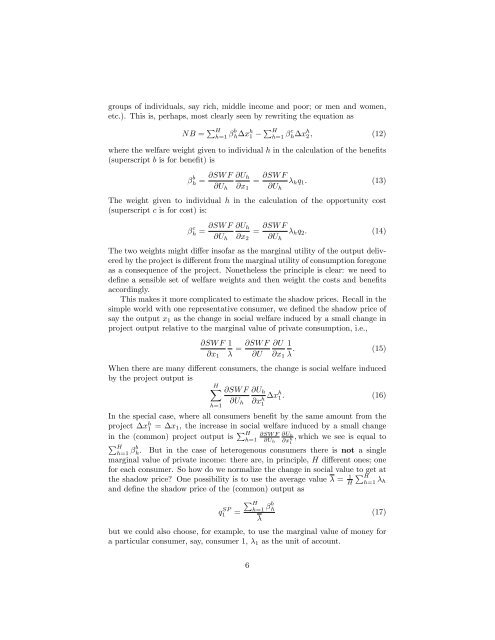Lecture Note 15: Social Cost Benefit Analysis - University of ...
Lecture Note 15: Social Cost Benefit Analysis - University of ...
Lecture Note 15: Social Cost Benefit Analysis - University of ...
Create successful ePaper yourself
Turn your PDF publications into a flip-book with our unique Google optimized e-Paper software.
groups <strong>of</strong> individuals, say rich, middle income and poor; or men and women,<br />
etc.). This is, perhaps, most clearly seen by rewriting the equation as<br />
NB = P H<br />
h=1<br />
b<br />
h x h 1<br />
P H<br />
h=1<br />
c<br />
h x h 2; (12)<br />
where the welfare weight given to individual h in the calculation <strong>of</strong> the bene…ts<br />
(superscript b is for bene…t) is<br />
b @SW F @Uh<br />
h = =<br />
@Uh @x1<br />
@SW F<br />
@Uh<br />
hq1: (13)<br />
The weight given to individual h in the calculation <strong>of</strong> the opportunity cost<br />
(superscript c is for cost) is:<br />
c @SW F @Uh<br />
h = =<br />
@Uh @x2<br />
@SW F<br />
@Uh<br />
hq2: (14)<br />
The two weights might di¤er ins<strong>of</strong>ar as the marginal utility <strong>of</strong> the output delivered<br />
by the project is di¤erent from the marginal utility <strong>of</strong> consumption foregone<br />
as a consequence <strong>of</strong> the project. Nonetheless the principle is clear: we need to<br />
de…ne a sensible set <strong>of</strong> welfare weights and then weight the costs and bene…ts<br />
accordingly.<br />
This makes it more complicated to estimate the shadow prices. Recall in the<br />
simple world with one representative consumer, we de…ned the shadow price <strong>of</strong><br />
say the output x1 as the change in social welfare induced by a small change in<br />
project output relative to the marginal value <strong>of</strong> private consumption, i.e.,<br />
@SW F<br />
@x1<br />
1 = @SW F<br />
@U<br />
@U<br />
@x1<br />
1 : (<strong>15</strong>)<br />
When there are many di¤erent consumers, the change is social welfare induced<br />
by the project output is<br />
HX @SW F<br />
h=1<br />
@Uh<br />
@Uh<br />
@x h 1<br />
x h 1: (16)<br />
In the special case, where all consumers bene…t by the same amount from the<br />
project x h 1 = x1, the increase in social welfare induced by a small change<br />
in the (common) project output is P H<br />
PH h=1<br />
h=1<br />
@SW F<br />
@Uh<br />
@Uh<br />
@x h 1<br />
, which we see is equal to<br />
b<br />
h. But in the case <strong>of</strong> heterogenous consumers there is not a single<br />
marginal value <strong>of</strong> private income: there are, in principle, H di¤erent ones; one<br />
for each consumer. So how do we normalize the change in social value to get at<br />
the shadow price? One possibility is to use the average value = 1 PH H h=1 h<br />
and de…ne the shadow price <strong>of</strong> the (common) output as<br />
q SP<br />
1<br />
=<br />
P H<br />
h=1<br />
b<br />
h<br />
(17)<br />
but we could also choose, for example, to use the marginal value <strong>of</strong> money for<br />
a particular consumer, say, consumer 1, 1 as the unit <strong>of</strong> account.<br />
6


